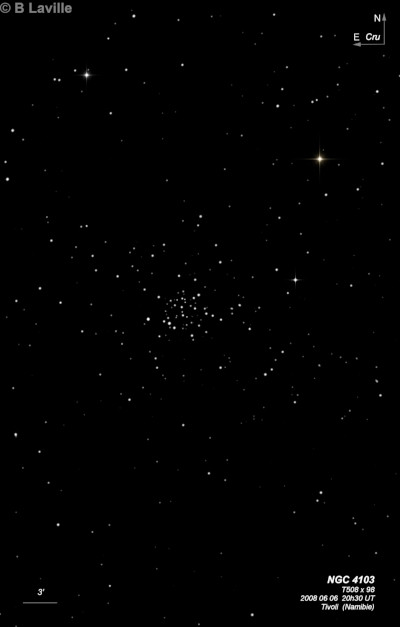
10x30mm Canon IS (3/27/19 - Tasmania): moderately bright cluster, perhaps 8' diameter, mottled but no obvious resolution. Situated within a large, glowing naked-eye patch of the Milky Way that includes two bright stars.
James Dunlop discovered NGC 4103 = D 291 = h3377 on 30 Apr 1826 and recorded "a cluster of small stars of mixt magnitudes, irregular figure, about 6' long and 4' broad." His position was 12' too far west.
John Herschel observed the cluster on 3 sweeps. On 14 Mar 1834 he logged "middle of a rich, large, irregularly round cluster; poor VI or rich VII, stars 10..14 mag; diam 5' with stragglers." His second observation was made under poor conditions: "cluster of stars class VII, pretty rich and compact, stars 10..12 mag, and nearly equal; diameter 5'; the whole field is in a state of wavy fluctuation, owing to the southeast wind, and so bad that each star is dilated into a large puff ball." The final sweep was recorded as "A 10th mag star in centre of a pretty rich close cluster; 5' diameter; irregularly round; stars 10..13 mag."
300/350mm - 13.1" (2/20/04 - Costa Rica): at 105x, ~60 stars mag 9.5-13 are resolved in a 8' region including roughly ten mag 10 stars. The cluster has a very interesting asymmetric arrangement with a perfect 5' string of five stars extending out of the cluster to the WSW. At the west end of the string is the 10th magnitude variable AI Crucis. Two other short strings on the eastern end of the cluster meet up and make a perfect arrow asterism. NGC 4103 is located 12' ESE of mag 6.6 HD 104971 and two degrees WSW of mag 3.6 Epsilon Crucis.
Notes by Steve Gottlieb